Some finches can be hard to ID! Here’s a handy guide: Tricky Finch ID Guide
Purple finch (Carpodacus purpureus)
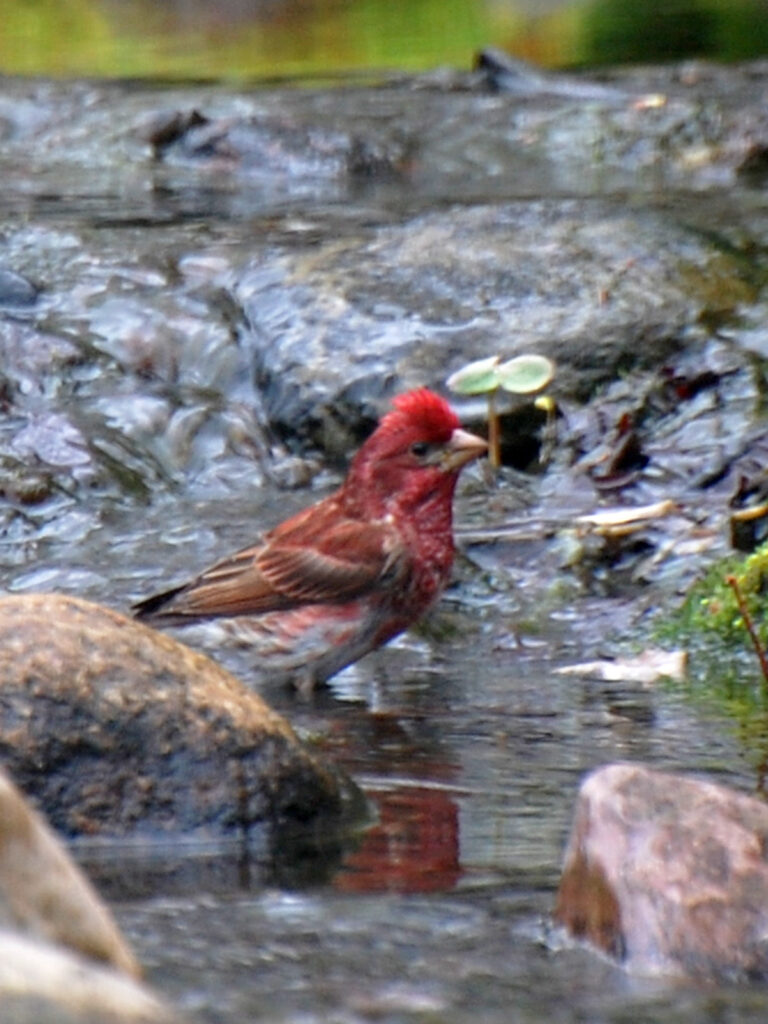
Although these are theoretically difficult to distinguish from house finches, when you see them, they’re unmistakably more colorful. Check out the vivid color on the purple finch compared with the brownish stripes on the house finch.
It’s a bit easier to distinguish the female house finch from the female purple finch than it is to distinguish between the males.
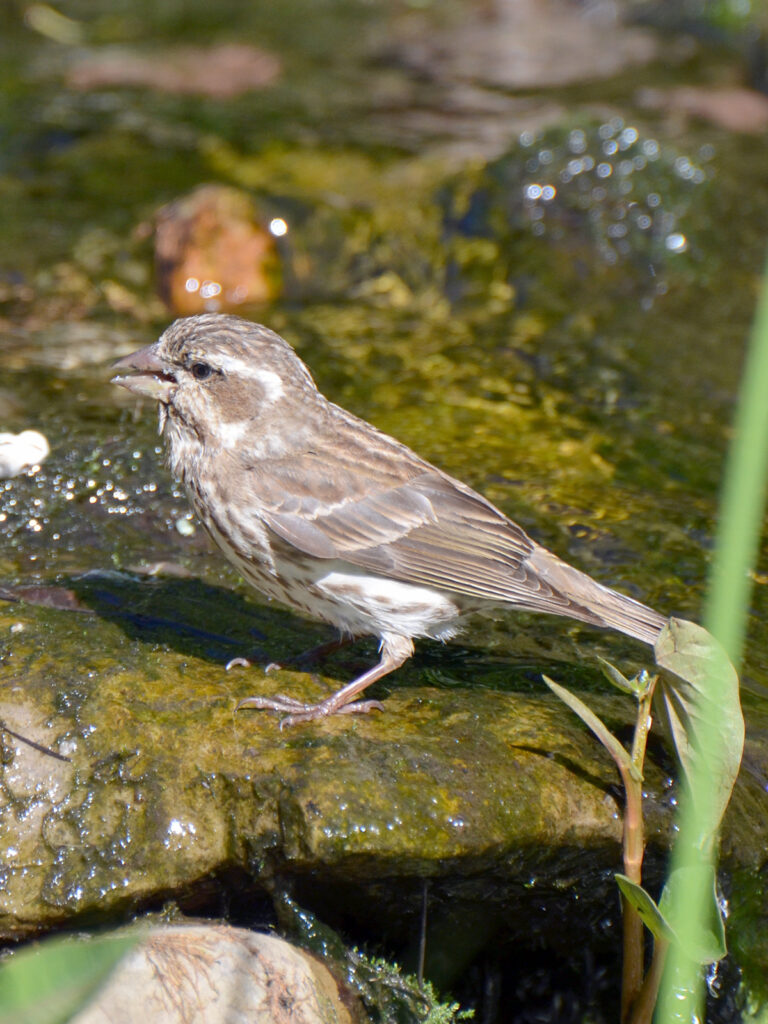
- Learn more:
- Cornell’s All About Birds: Purple finch
- American Bird Conservancy: Bird of the Week
| YR | J | F | M | A | M | J | J | A | S | O | N | D |
| 24 | · | |||||||||||
| 23 | · | 2 | · | · | · | · | · | · | ||||
| 22 | · | · | · | · | 2 | · | 1 | · | · | |||
| 21 | · | · | · | · | · | · | 1 | · | · | · | · | |
| 20 | · | · | · | · | · | · | · | · | · | · | ||
| 19 | · | · | 1 | · | · | · | · | · | · | |||
| 18 | · | 2 | 2 | · | · | · | · | · | · | |||
| 17 | · | · | 2 | · | · | · | · | · | · | · | ||
| 16 | · | · | · | 2 | · | · | · | · | · | |||
| 15 | · | · | 3 | 2 | 1 | · | · | · | · | |||
| 14 | · | 1 | · | · | · | · | · | · | · | |||
| 13 | · | 3 | 1 | 1 | · | 1 | · | · | 2 | |||
| 12 | · | · | · | · | · | · | · | · | · | |||
| 11 | · | · | · | · | · | · | · | · | · | · | · | |
| 10 | · | · | · | · | · | · | · | · | · | · | · | · |
| 09 | · | · | · | · | · | · | · | · | · | · | · | · |
| 08 | · | · | · | · | · | · | · | · | · | · | · | · |
| 07 | · | · | · | · | · | · | · | · | · | · | · | · |
| 06 | · | · | · | 2 | · | · | · | · | · | · | · | · |
| 05 | · | · | · | 2 | · | · | · | · | · | · | · | · |
| 04 | · | · | · | · | · | 1 | · | · | · | · | · | · |
| 03 | · | · | · | · | · | · | · | · | · | · | · | · |
| 02 | · | · | · | · | · | · | · | · | · | · | · | · |
| 01 | · | · | · | · | · | · |
House finch (Carpodacus mexicanus)
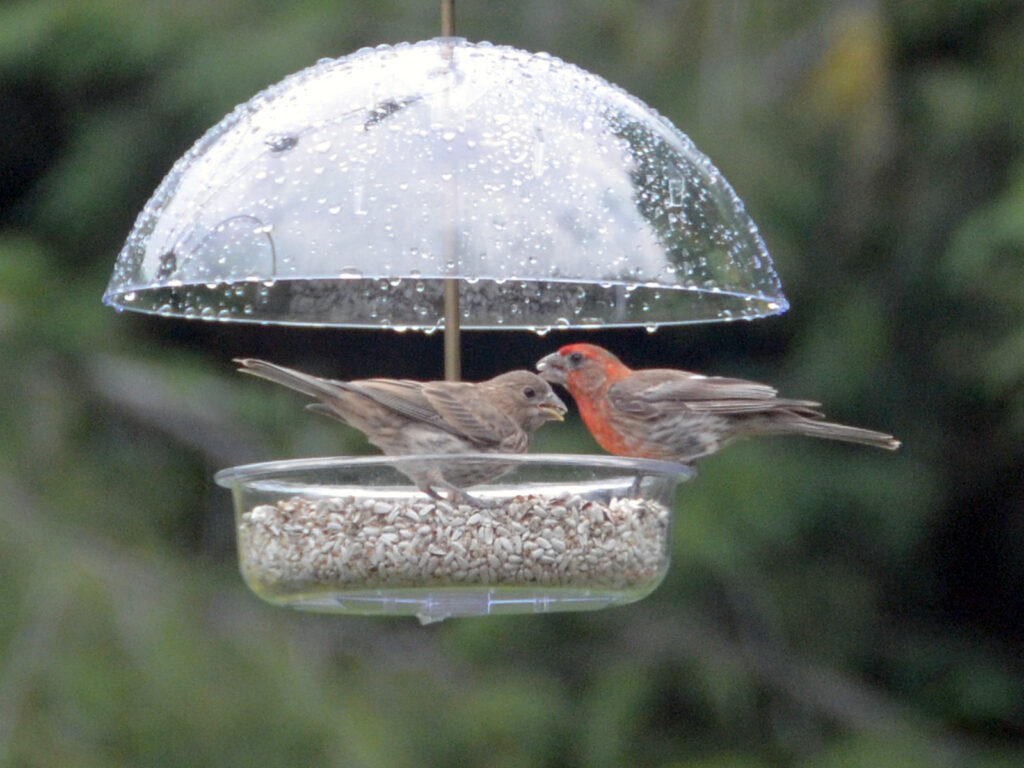
There are fewer of these birds since the house finch eye disease hit. Years ago we often had them nesting in our door wreath, in our hanging baskets, and other places around the house, but now we rarely see them nesting.
On the other hand, they actually aren’t native here anyway, having been introduced by pet stores. Fewer house finches will make it easier on other native birds.
The male (on the right) and female (on the left) often feed together at the feeder: one turned in one direction, the other in the opposite direction.
- Learn more:
- Cornell’s All About Birds: House finch
- Nature Cons Cool Green Science: Why do house finches love your hanging plants
| YR | J | F | M | A | M | J | J | A | S | O | N | D |
| 24 | 2 | |||||||||||
| 23 | 5 | 4 | 2 | 3 | 5 | 1 | 2 | 1 | ||||
| 22 | 2 | 2 | 2 | 2 | 4 | 2 | 1 | 5 | 2 | |||
| 21 | 22 | 20 | 6 | 4 | 4 | 2 | 2 | 1 | 1 | 2 | 3 | |
| 20 | 5 | 4 | 6 | 4 | 3 | 2 | 5 | 3 | 4 | 5 | ||
| 19 | 3 | 2 | 2 | 2 | 2 | · | · | 1 | · | |||
| 18 | 2 | 2 | 1 | 2 | 5 | 6 | 7 | 4 | 2 | |||
| 17 | · | 2 | 2 | 2 | 3 | 2 | · | 1 | · | 1 | ||
| 16 | 2 | 2 | 2 | 1 | 2 | · | · | · | · | |||
| 15 | 3 | 2 | 3 | 2 | 3 | 2 | · | · | · | |||
| 14 | 2 | 4 | 2 | 2 | 4 | · | 1 | 1 | · | |||
| 13 | 3 | 3 | 1 | · | · | · | · | · | · | |||
| 12 | · | 1 | 2 | 1 | 1 | 1 | · | · | · | |||
| 11 | 2 | 2 | 2 | 3 | 1 | 1 | · | · | · | · | · | |
| 10 | 2 | 3 | 3 | 2 | 3 | · | 3 | · | · | 4 | 3 | 2 |
| 09 | 3 | 6 | 6 | 3 | 1 | 1 | 1 | 1 | · | 1 | 3 | 4 |
| 08 | 9 | 12 | 5 | 3 | 3 | 4 | 2 | 4 | 4 | 3 | 12 | 3 |
| 07 | 27 | 10 | 5 | 9 | 2 | 2 | 2 | 1 | 2 | 2 | 15 | 28 |
| 06 | 26 | 12 | 3 | 3 | 3 | 3 | 2 | 2 | · | 4 | 6 | 18 |
| 05 | 13 | 8 | 7 | 6 | 2 | 3 | 1 | 3 | 1 | 9 | 4 | 4 |
| 04 | · | 2 | 2 | 4 | 2 | 2 | 2 | 1 | · | 2 | 4 | 15 |
| 03 | · | · | 2 | 5 | 2 | 4 | 3 | 2 | 1 | 1 | 1 | 1 |
| 02 | · | · | 2 | 4 | 8 | 7 | 5 | 2 | 2 | 2 | 1 | · |
| 01 | · | · | 2 | · | 1 | · |
White-winged crossbill (Loxia leucoptera)
We’ve only seen this one once. A very unusual bird. This was one I had to send in to Cornell to confirm identification. (This isn’t a very good photo since it was taken through the screen of my kitchen window.)
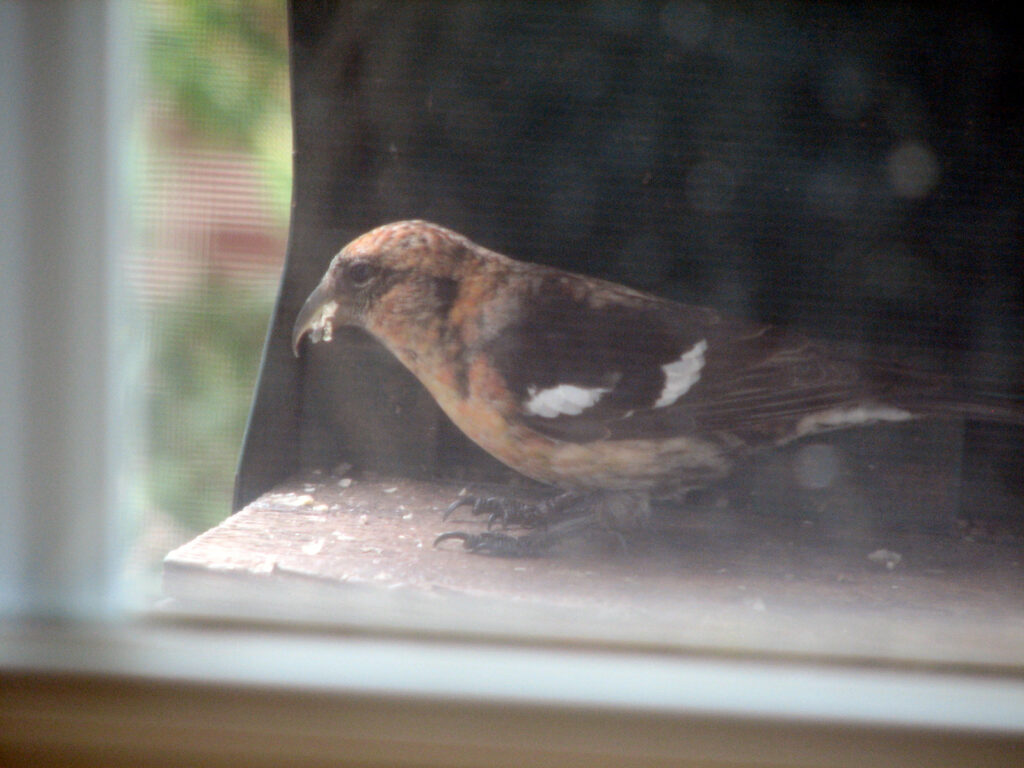
- Learn more:
- Cornell’s All About Birds: White-winged crossbill
| YR | J | F | M | A | M | J | J | A | S | O | N | D |
| 24 | · | |||||||||||
| 23 | · | · | · | · | · | · | · | · | ||||
| 22 | · | · | · | · | · | · | · | · | · | |||
| 21 | · | · | · | · | · | · | · | · | · | · | · | |
| 20 | · | · | · | · | · | · | · | · | · | · | ||
| 19 | · | · | · | · | · | · | · | · | · | |||
| 18 | · | · | · | · | · | · | · | · | · | |||
| 17 | · | · | · | · | · | · | · | · | · | · | ||
| 16 | · | · | · | · | · | · | · | · | · | |||
| 15 | · | · | · | · | · | · | · | · | · | |||
| 14 | · | · | · | · | · | · | · | · | · | |||
| 13 | · | · | · | · | · | · | · | · | · | |||
| 12 | · | · | · | · | · | · | · | · | · | |||
| 11 | · | · | · | · | · | · | · | · | · | · | · | |
| 10 | · | · | · | · | · | · | · | · | · | · | · | · |
| 09 | · | · | · | · | · | · | · | · | · | · | · | · |
| 08 | · | · | · | 1 | · | · | · | · | · | · | · | · |
| 07 | · | · | · | · | · | · | · | · | · | · | · | · |
| 06 | · | · | · | · | · | · | · | · | · | · | · | · |
| 05 | · | · | · | · | · | · | · | · | · | · | · | · |
| 04 | · | · | · | · | · | · | · | · | · | · | · | · |
| 03 | · | · | · | · | · | · | · | · | · | · | · | · |
| 02 | · | · | · | · | · | · | · | · | · | · | · | · |
| 01 | · | · | · | · | · | · |
Common redpoll (Carduelis flammea)
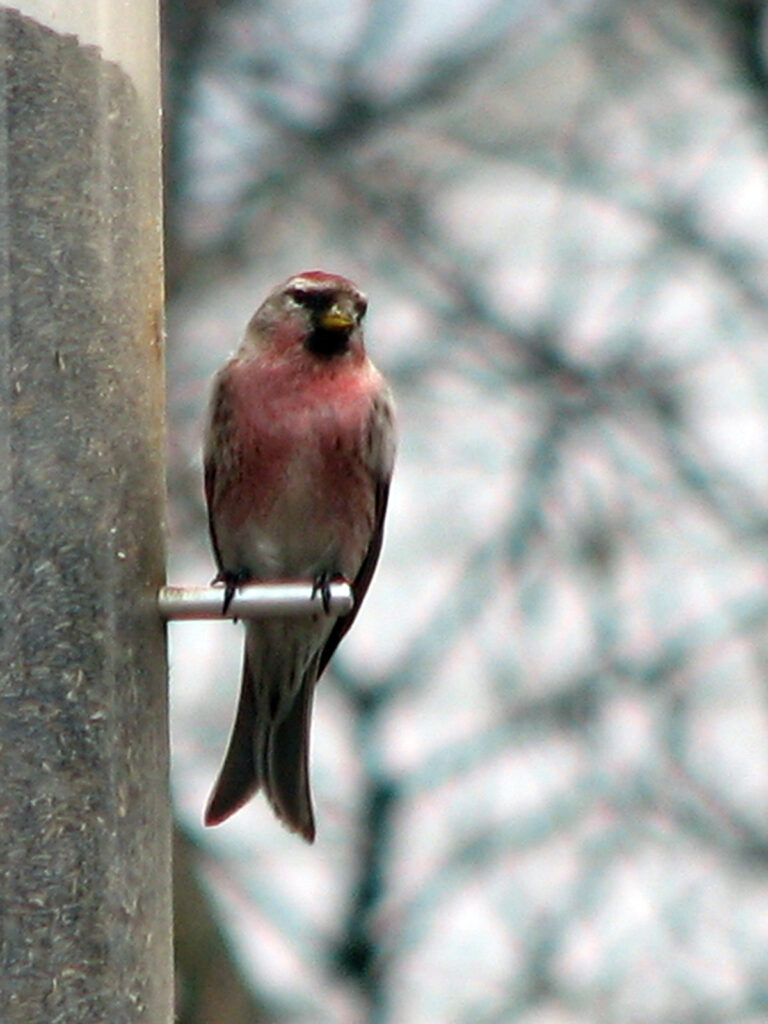
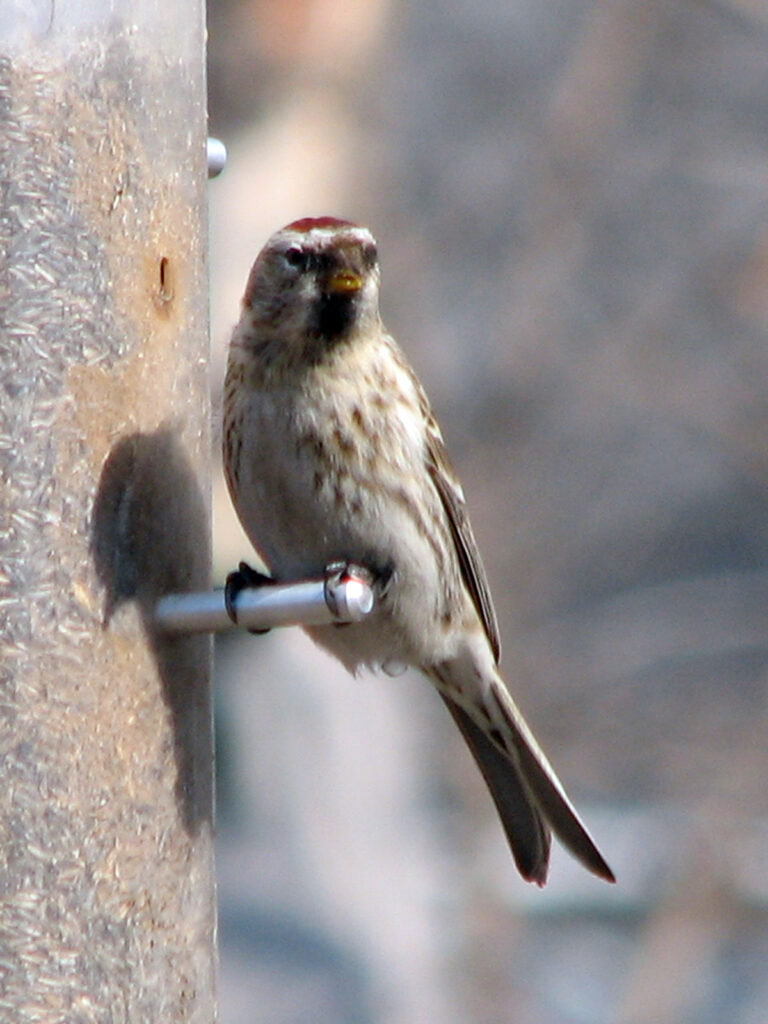
We don’t often see these, but it’s nice when they visit. The male is on the left and the female is on the right.
- Learn more:
- Cornell’s All About Birds: Common redpoll
- Bird Watcher’s General Store: Redpolls
| YR | J | F | M | A | M | J | J | A | S | O | N | D |
| 24 | · | |||||||||||
| 23 | · | · | · | · | · | · | · | · | ||||
| 22 | · | · | · | · | · | · | · | · | · | |||
| 21 | 20 | 20 | 12 | 1 | · | · | · | · | · | · | · | |
| 20 | · | · | · | · | · | · | · | · | · | · | ||
| 19 | · | · | · | · | · | · | · | · | · | |||
| 18 | · | · | · | · | · | · | · | · | · | |||
| 17 | · | · | · | · | · | · | · | · | · | · | ||
| 16 | · | · | · | · | · | · | · | · | · | |||
| 15 | · | · | · | · | · | · | · | · | · | |||
| 14 | · | · | · | · | · | · | · | · | · | |||
| 13 | · | · | · | · | · | · | · | · | · | |||
| 12 | · | · | · | · | · | · | · | · | · | |||
| 11 | · | · | · | · | · | · | · | · | · | · | · | |
| 10 | · | · | · | · | · | · | · | · | · | · | · | · |
| 09 | · | · | · | · | · | · | · | · | · | · | · | · |
| 08 | · | · | 1 | 3 | · | · | · | · | · | · | · | · |
| 07 | · | · | · | · | · | · | · | · | · | · | · | · |
| 06 | · | · | · | · | · | · | · | · | · | · | · | · |
| 05 | · | · | · | · | · | · | · | · | · | · | · | · |
| 04 | · | · | · | · | · | · | · | · | · | · | · | · |
| 03 | · | · | · | · | · | · | · | · | · | · | · | · |
| 02 | · | · | · | · | · | · | · | · | · | · | · | · |
| 01 | · | · | · | · | · | · |
Pine siskin (Carduelis pinus)
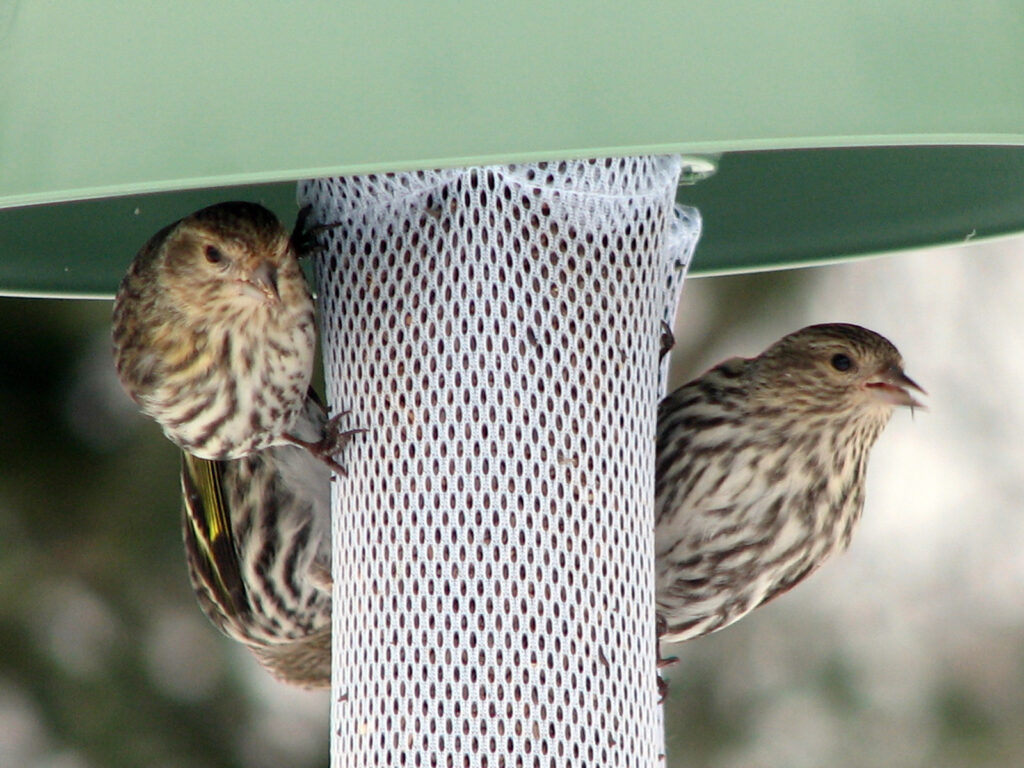
One of the “irruptive” species — either a feast or a famine of them. One year we had a huge flock of about 70 birds; most years we’ve had none. At first it was tricky to identify them, but now I just look for the house finch-looking bird with the yellowish tinge.
- Learn more:
- Cornell’s All About Birds: Pine siskin
- American Bird Conservancy: Bird of the Week
- Bird Watcher’s General Store: Pine siskin
- Hilton Pond: Another long-distance siskin
| YR | J | F | M | A | M | J | J | A | S | O | N | D |
| 24 | · | |||||||||||
| 23 | · | · | · | · | · | · | · | · | ||||
| 22 | · | · | · | · | · | · | · | · | · | |||
| 21 | · | · | · | · | 4 | · | · | · | · | · | · | |
| 20 | · | · | · | · | · | · | · | 12 | · | 9 | ||
| 19 | · | · | · | · | · | · | · | · | · | |||
| 18 | · | · | · | · | · | · | · | · | · | |||
| 17 | · | · | · | · | · | · | · | · | · | · | ||
| 16 | · | · | · | · | · | · | · | · | · | |||
| 15 | · | · | · | · | · | · | · | · | · | |||
| 14 | · | · | · | · | · | · | · | 1 | · | |||
| 13 | · | 2 | 7 | · | · | · | · | · | · | |||
| 12 | · | · | · | · | · | · | · | · | · | |||
| 11 | · | · | 3 | · | · | · | · | · | · | · | · | |
| 10 | · | · | · | · | · | · | · | · | · | 8 | · | · |
| 09 | 30 | 50 | 39 | 70 | 21 | · | · | · | · | · | · | · |
| 08 | · | · | · | · | 7 | · | · | · | · | · | · | 6 |
| 07 | · | · | · | · | · | · | · | · | · | · | · | · |
| 06 | · | · | · | · | · | · | · | · | · | · | · | · |
| 05 | · | · | · | · | · | · | · | · | · | 2 | · | · |
| 04 | · | · | · | · | · | · | · | · | · | · | · | · |
| 03 | · | · | · | · | · | · | · | · | · | · | · | · |
| 02 | · | · | · | · | 7 | · | · | · | · | · | · | · |
| 01 | · | · | · | · | · | · |
American goldfinch (Carduelis tristis)
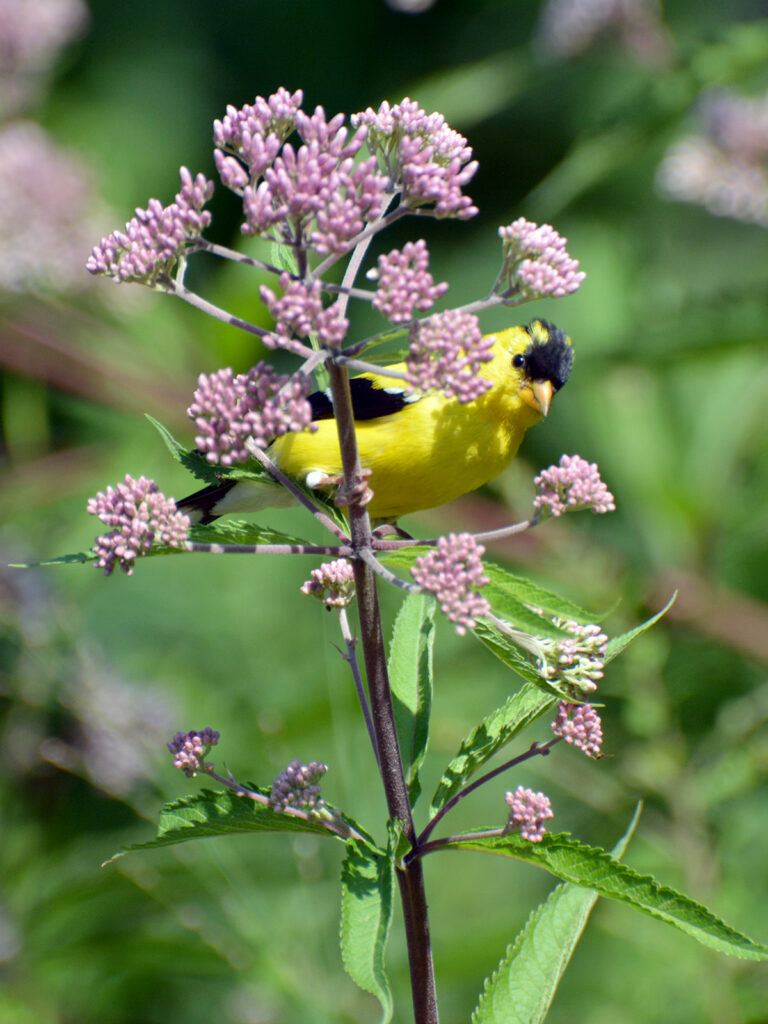
Goldfinches are here all year, though some people think it returns in the spring. It’s hard to believe that such a brilliantly-colored bird could be missed. But in winter, it’s in its dull winter garb, gobbling up nyger seed.
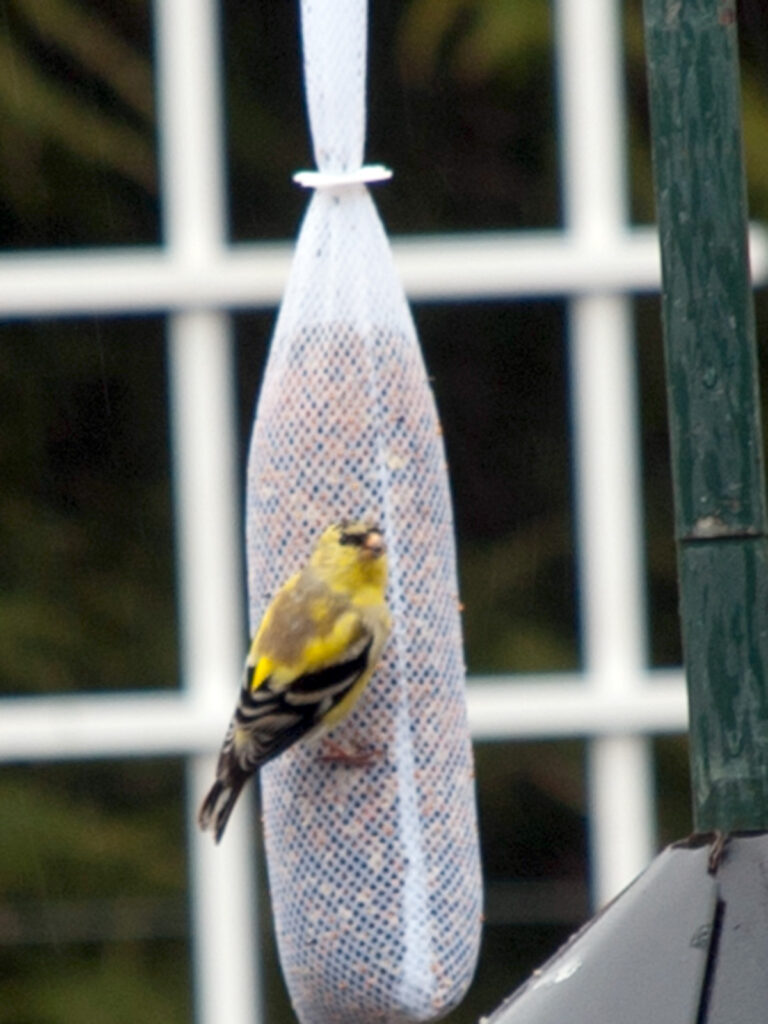
Here the goldfinch is molting and donning its summer feathers. Some people mistakenly believe that the goldfinches (or “wild canaries”) are returning. They’ve been here all along, though, but in their drab winter attire. Their colors are best when they have a healthy diet, and females judge the males on the basis of the goldest gold and the largest, blackest caps.
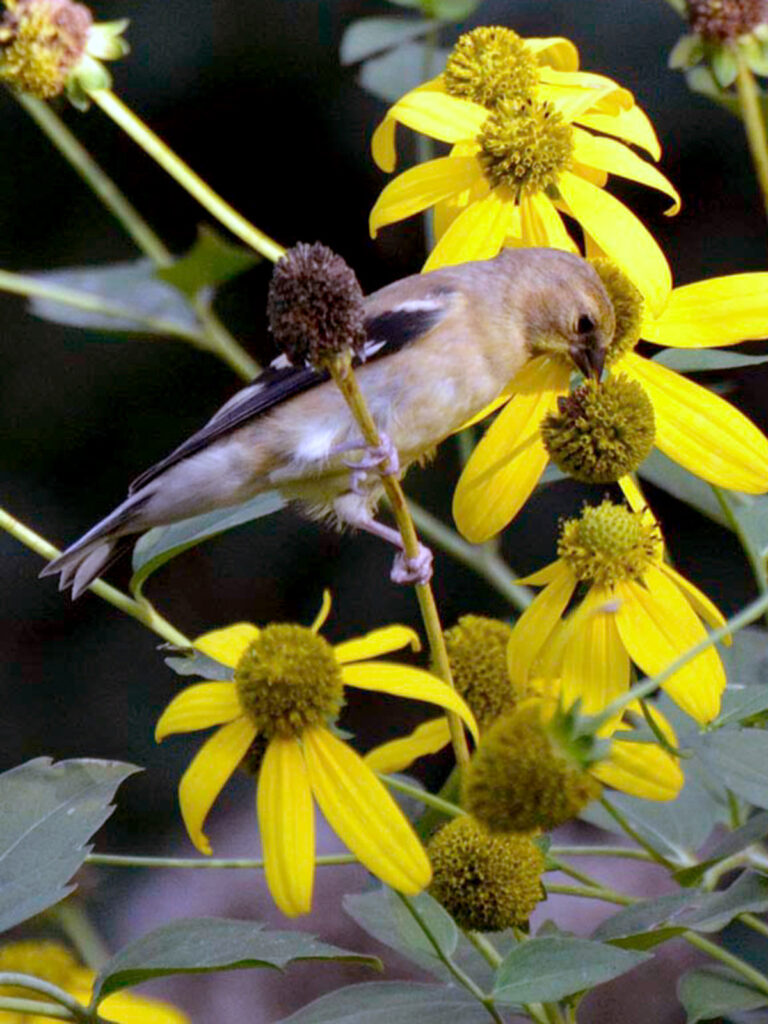
Here’s its winter appearance. Goldfinches like many natural sources of seed, such as this hyssop.
It was interesting to learn that goldfinches are virtually vegetarians, unlike most birds. That explains why they nest in the fall, when seeds are ripe, rather than in the spring when caterpillars are plentiful.
- Learn more:
- American Bird Conservancy: Bird of the Week
- Cornell’s All About Birds: American goldfinch
| YR | J | F | M | A | M | J | J | A | S | O | N | D |
| 24 | 1 | |||||||||||
| 23 | · | 2 | 2 | 3 | 2 | 5 | 4 | 4 | ||||
| 22 | 2 | 1 | 4 | 3 | 3 | 5 | 4 | 8 | 2 | |||
| 21 | 3 | 4 | 1 | 2 | 2 | 2 | 2 | 4 | 5 | 12 | 3 | |
| 20 | 2 | 3 | 6 | 2 | 3 | 4 | 11 | 5 | 5 | 3 | ||
| 19 | 2 | 4 | 3 | 2 | 5 | 3 | 11 | 10 | 6 | |||
| 18 | · | 5 | 3 | 4 | 4 | 4 | 6 | 5 | 1 | |||
| 17 | · | 5 | 10 | 5 | 2 | 6 | 7 | 25 | 6 | 2 | ||
| 16 | 4 | 4 | 4 | 6 | 3 | · | · | 5 | 1 | |||
| 15 | · | 4 | 5 | 3 | 2 | 2 | 8 | · | · | |||
| 14 | 3 | 4 | 5 | 4 | 3 | 5 | 10 | 10 | 1 | |||
| 13 | 2 | 9 | 8 | 3 | 2 | 2 | 6 | 4 | 10 | |||
| 12 | 5 | 5 | 2 | 3 | 2 | 2 | 7 | 2 | 6 | |||
| 11 | 6 | 25 | 9 | 3 | 4 | 2 | · | 2 | 2 | 30 | 3 | |
| 10 | 42 | 31 | 16 | 5 | 4 | 1 | 2 | 2 | 2 | 1 | 6 | 5 |
| 09 | 50 | 8 | 5 | 4 | 2 | 3 | 3 | 5 | 3 | 5 | 25 | 28 |
| 08 | 18 | 35 | 28 | 4 | 3 | 6 | 3 | 2 | 10 | 10 | 20 | 30 |
| 07 | 18 | 7 | 3 | 6 | 3 | 2 | 2 | 2 | 6 | 2 | 1 | 11 |
| 06 | 3 | 1 | 7 | 15 | 5 | 2 | 2 | 6 | 10 | 8 | 6 | 7 |
| 05 | 30 | 45 | 20 | 12 | 14 | 2 | 1 | 8 | 25 | 6 | 1 | 1 |
| 04 | 70 | 70 | 50 | 14 | 8 | 8 | 4 | 2 | 50 | 50 | 60 | 30 |
| 03 | · | 1 | · | 3 | 7 | 4 | 7 | 10 | 20 | 21 | 18 | 22 |
| 02 | · | · | · | 2 | 9 | 9 | 3 | 2 | 13 | 8 | 1 | · |
| 01 | 1 | · | 5 | 3 | 2 | · |
House sparrow (Passer domesticus)
This non-native bird, like the European starling, is a true plague. In our yard, they eat all our bird seed, and they chase other birds away by ganging up on them, taking over nesting sites, and destroying eggs or even the nestlings of native birds.
And their impact is greater in the world beyond our yard.
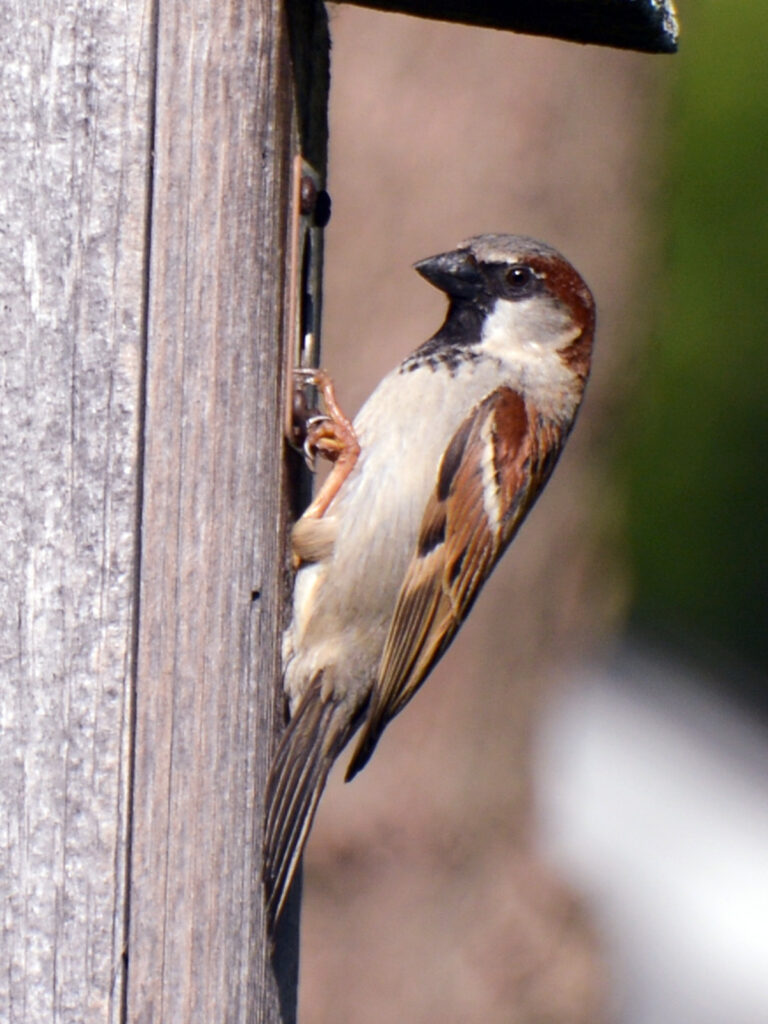
I’ve read that it’s actually a weaver FINCH, not a true sparrow. Native sparrows are very nice birds, so it’ important to learn to distinguish between them and house sparrows. (And in their native range, house sparrows would be welcome, too.)
The male is pictured at the top and the female house sparrow below.
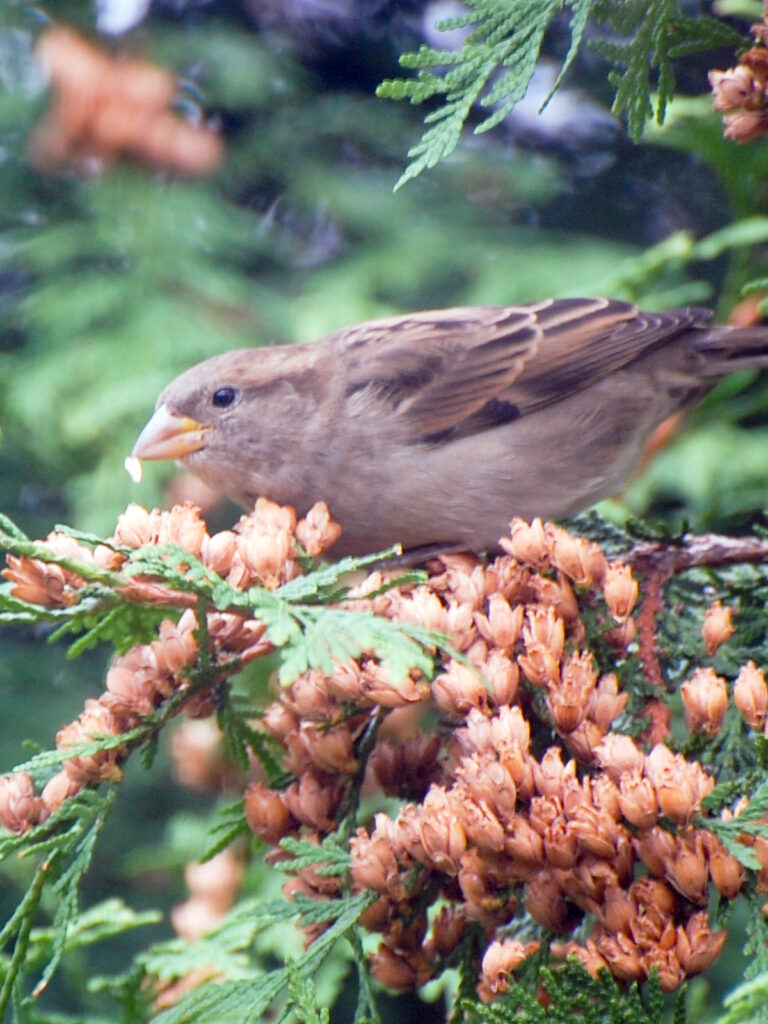
- Learn more:
- Our Habitat Garden: More about house sparrows in Our Habitat Garden
- Nature Cons. Cool Green Science: Where have all the house sparrows gone?
- Cornell’s All About Birds: House Sparrow
| YR | J | F | M | A | M | J | J | A | S | O | N | D |
| 24 | 2 | |||||||||||
| 23 | 2 | 2 | 4 | 3 | 5 | 7 | 10 | 7 | ||||
| 22 | 5 | 2 | 2 | 2 | 2 | 4 | 4 | 8 | 7 | |||
| 21 | 4 | 4 | 4 | 4 | 3 | 3 | 4 | 12 | 7 | 6 | 4 | |
| 20 | 3 | 4 | 3 | 7 | 7 | 6 | 12 | 4 | 20 | 10 | ||
| 19 | 5 | 3 | 2 | 3 | 10 | 5 | 5 | 4 | 12 | |||
| 18 | 2 | 3 | 4 | 2 | 10 | 12 | 6 | 7 | 8 | |||
| 17 | 4 | 7 | 7 | 15 | 60 | 60 | 20 | 25 | 30 | 17 | ||
| 16 | 4 | 5 | 5 | 5 | 25 | · | · | 20 | 15 | |||
| 15 | 5 | 4 | 6 | 5 | 35 | 50 | 30 | · | · | |||
| 14 | 13 | 12 | 6 | 30 | 30 | 30 | 20 | 35 | 25 | |||
| 13 | 8 | 8 | 4 | 3 | 9 | 15 | 30 | 20 | 35 | |||
| 12 | 6 | 5 | 3 | 5 | 20 | 25 | 20 | 20 | 35 | |||
| 11 | 30 | 20 | 15 | 6 | 5 | · | · | · | 30 | 30 | 40 | |
| 10 | 20 | 15 | 7 | 4 | 6 | 3 | 4 | · | 1 | 10 | 30 | 30 |
| 09 | 8 | 8 | 7 | 5 | 3 | 5 | 30 | 40 | 40 | 20 | 30 | 14 |
| 08 | 30 | 15 | 10 | 5 | 4 | 10 | 3 | 40 | 30 | 20 | 25 | 20 |
| 07 | 30 | 20 | 10 | 10 | 6 | 6 | 20 | 40 | 50 | 30 | 50 | 60 |
| 06 | 80 | 90 | 40 | 7 | 6 | 5 | 35 | 50 | 70 | 50 | 70 | 50 |
| 05 | 80 | 70 | 50 | 12 | 9 | 6 | 25 | 90 | 90 | 90 | 90 | 90 |
| 04 | 40 | 50 | 40 | 15 | 12 | 30 | 40 | 80 | 50 | 50 | 90 | 60 |
| 03 | 40 | 40 | 45 | 25 | 7 | 20 | 30 | 80 | 90 | 90 | 90 | 55 |
| 02 | 70 | 75 | 60 | 40 | 10 | 8 | 25 | 80 | 80 | 30 | 80 | 60 |
| 01 | 80 | 80 | 80 | 50 | 60 | 65 |
